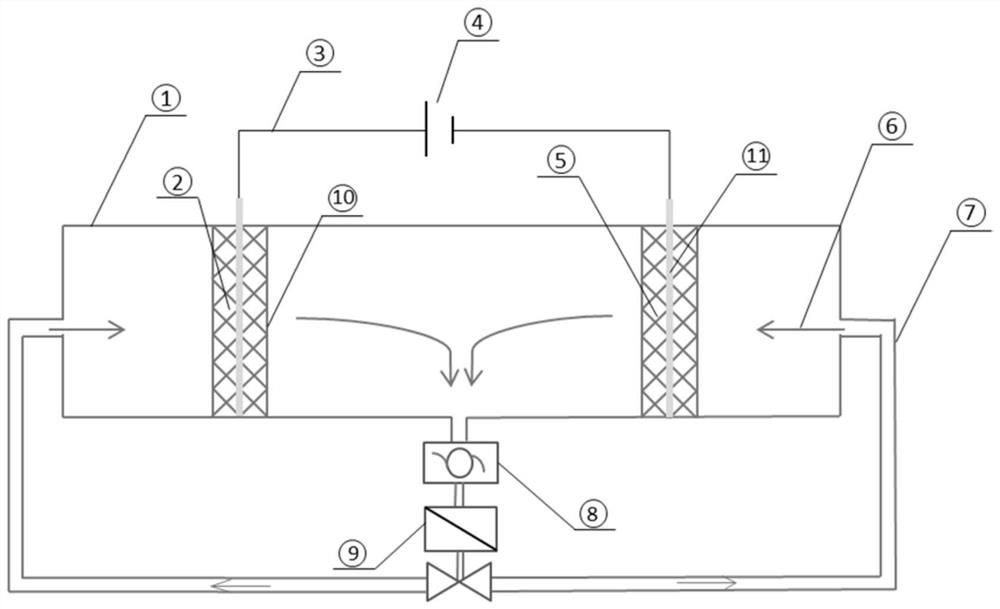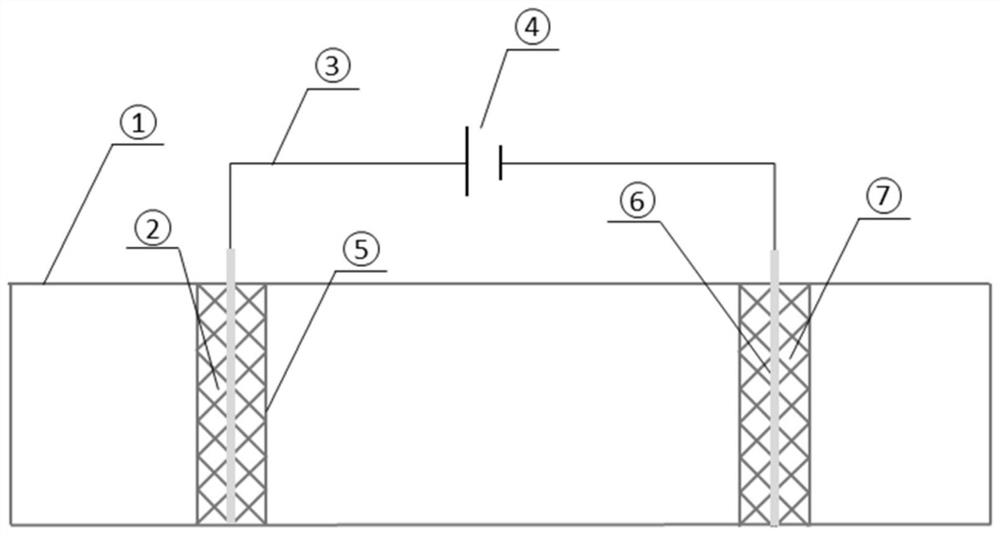Iron electrochemical water treatment method for convection enhanced ion mass transfer
An electrochemical and water treatment technology, applied in chemical instruments and methods, water/sewage treatment, water/sludge/sewage treatment, etc. Electrochemical reactivity, reduction of electrolysis rate, effect of large specific surface area
- Summary
- Abstract
- Description
- Claims
- Application Information
AI Technical Summary
Problems solved by technology
Method used
Image
Examples
Embodiment 1
[0033] Methyl orange (MO) wastewater was treated by an electrochemical water treatment technology with convection-enhanced iron ion mass transfer (according to figure 1 The structure is built, the devices used are conventional devices in the field, and the materials used are all commercially available materials. The electrolytic cell is opened for convection, and the opening is located in the middle of the side of the electrolytic cell. The same below), using Na 2 SO 4 Adjust the conductivity of the waste liquid to 1000 us / cm, the initial concentration of methyl orange is 50 mg / L, and the treatment steps are as follows:
[0034] (1) Iron particles with a diameter of 2 mm were uniformly fixed with a porous insulating grid plate as the anode, and carbon particles with a diameter of 3 mm were uniformly fixed with a porous insulating grid plate as the cathode. At the same time, the current collector titanium rod was placed between the particle electrodes During the period, the e...
Embodiment 2
[0045] Heavy metal chromium ion wastewater is treated by an electrochemical water treatment technology with convection enhanced iron ion mass transfer (according to figure 1 The structure is built, and the devices used are conventional devices in the field, and the materials are commercially available materials. The electrolytic cell is opened for convection, and the opening is located in the middle of the side of the electrolytic cell. The same below), use Na 2 SO 4 Adjust the conductivity of the waste liquid to 800 us / cm, and the initial chromium ion concentration to 20 mg / L. The treatment steps are as follows:
[0046] (1) Iron filings with a porosity of 10% were fixed with a porous insulating grid, and a titanium rod was inserted into the current collector as an anode. Carbon particles with a porosity of 20% were fixed with a porous insulating grid, and a titanium rod was inserted into the current collector. as a cathode;
[0047] (2) Place the loaded cathode and anode ...
Embodiment 3
[0056] Fluoride ion-containing wastewater is treated by an electrochemical water treatment method with convective enhanced aluminum ion mass transfer (such as figure 1 ), with Na 2 SO 4 Adjust the conductivity of the waste liquid to 1500 us / cm, and the initial concentration of fluoride ions to 20 mg / L. The steps are as follows:
[0057] (1) Aluminum particles with a diameter of 3 mm were evenly fixed with a porous insulating grid plate as the anode, and carbon particles with a diameter of 3 mm were uniformly fixed with a porous insulating grid plate as the cathode, and the current collector titanium rod was placed between the particle electrodes between;
[0058] (2) Place the loaded two electrodes in a 320 mL electrolytic cell with a distance of 10 cm, pour the fluorine-containing waste liquid into the electrolytic cell, open holes at both ends of the electrolytic cell to connect the peristaltic pump connecting pipe for flow, and turn on the power carry out the electrolyti...
PUM
| Property | Measurement | Unit |
|---|---|---|
| diameter | aaaaa | aaaaa |
| porosity | aaaaa | aaaaa |
Abstract
Description
Claims
Application Information
 Login to View More
Login to View More - R&D
- Intellectual Property
- Life Sciences
- Materials
- Tech Scout
- Unparalleled Data Quality
- Higher Quality Content
- 60% Fewer Hallucinations
Browse by: Latest US Patents, China's latest patents, Technical Efficacy Thesaurus, Application Domain, Technology Topic, Popular Technical Reports.
© 2025 PatSnap. All rights reserved.Legal|Privacy policy|Modern Slavery Act Transparency Statement|Sitemap|About US| Contact US: help@patsnap.com



